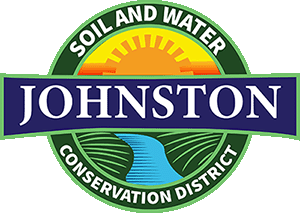
Soil and Water Conservation
Johnston County, North Carolina

Johnston County, North Carolina
THE CONSERVATION RESERVE ENHANCEMENT PROGRAM
Partnerships That Make The Most of Farmland Conservation
What Is CREP?
The Conservation Reserve Enhancement Program (CREP) is a voluntary land retirement program that helps agricultural producers protect environmentally sensitive land, decrease erosion, restore wildlife habitat, and safeguard ground and surface water. The program is a partnership between producers and tribal. State, and Federal governments and, in some cases, private groups. CREP is an offshoot of the country's largest private-lands environmental improvement program--the Conservation Reserve Program (CRP).
Like CRP, CREP is administered by the USDA's Farm Service Agency (FSA). CREP combines efforts of several USDA agencies, State agencies, Indian tribes, conservation and other private organizations, and citizens concerned about farmland conservation. By combining CRP resources with State, tribal, and private programs, CREP provides farmers and ranchers with a sound financial package for improving their operations. CREP addresses high-priority conservation issues of both local and national significance, such as agricultural runoff, loss of critical wildlife habitat, and soil erosion. CREP is community-based, centered around local participation and leadership. Project development begins with State, local, and tribal governments, which also contribute funding and technical support.
The result? A unique program that highlights specific community needs. For instance, several CREP partners are using the program to safeguard drinking water, while others are focusing on protecting wildlife and revitalizing rivers and bays.
Protecting Land & Water
CREP supports increased use of filter strips and forested buffers. These conservation practices help protect streams, lakes, and rivers from sedimentation and agricultural runoff. CREP also helps landowners develop and restore wetlands through planting appropriate ground cover. Ground cover improves soil, water, and air quality, and also provides habitat for threatened and endangered wildlife species. By maintaining clear goals and requiring annual monitoring, CREP measures progress and ensures success.
What's In It FOR ME?
For the landowner, CREP is not just a cost-effective way to address rural environmental problems and meet regulatory requirements, it can increase farm income as well. To encourage producers to join, States and private organizations involved in CREP frequently offer financial incentives in addition to those available with the regular CRP. CREP is convenient for producers because it is based on the familiar, highly successful CRP model. Land must be owned or leased for at least 1 year to be eligible and must be physically and legally capable of being cropped in a normal manner. Enrollment can be on a continuous basis, permitting applicants to join the program at any time rather than waiting for specific signup periods.
Like CRP, CREP contracts require a 10-to15-year commitment to keep lands out of agricultural production, guaranteeing lasting benefits. Many States offer landowners additional incentives to enroll CREP land in permanent easements.
How Do I GET INVOLVED?
Because CREP is community based, it is available only in designated areas within States or tribal lands that have developed CREP partnerships with USDA. Enrollment in a State is limited to size. To determine if your community is involved in CREP and if you may qualify, contact your local FSA office.
How Do I LEARN MORE?
To learn m ore about the Conservation Reserve Enhancement Program, contact your local or State FSA office, or write to the following address:
USDA FSA Public Affairs Staff, 1400 Independence Avenue, SW STOP 0506, Washington, D.C. 20250-0506
More information on FSA and its programs is available on FSA's Web site, at http://www.fsa.usda.gov/conservation.
The U.S. Department of Agriculture (USDA) prohibits discrimination in all its programs and activities on the basis of race, color, national origin, sex, religion, age, disability, political beliefs, sexual orientation, and marital or family status. (Not all prohibited bases apply to all programs.) Persons with disabilities who require alternative means for communication of program information (Braille, large print, audiotape, etc.) should contact USDA's TARGET Center at (202)720-2600 (voice and TDD).
To file a complaint of discrimination, write USDA, Director, Office of Civil Rights, Room 326-W. Whitten Building, 14th and Independence Avenue, SW. Washington, D.C. 20250-9410 or call (202) 720-5964 (voice or TDD). USDA is an equal opportunity provider and employer.
PA-1702 September 2001